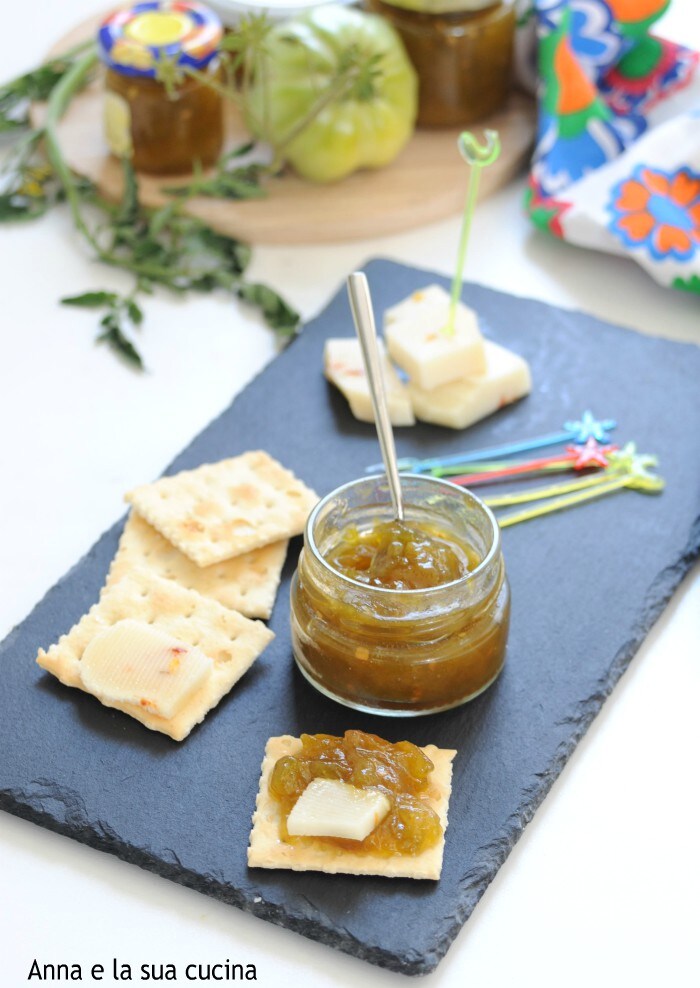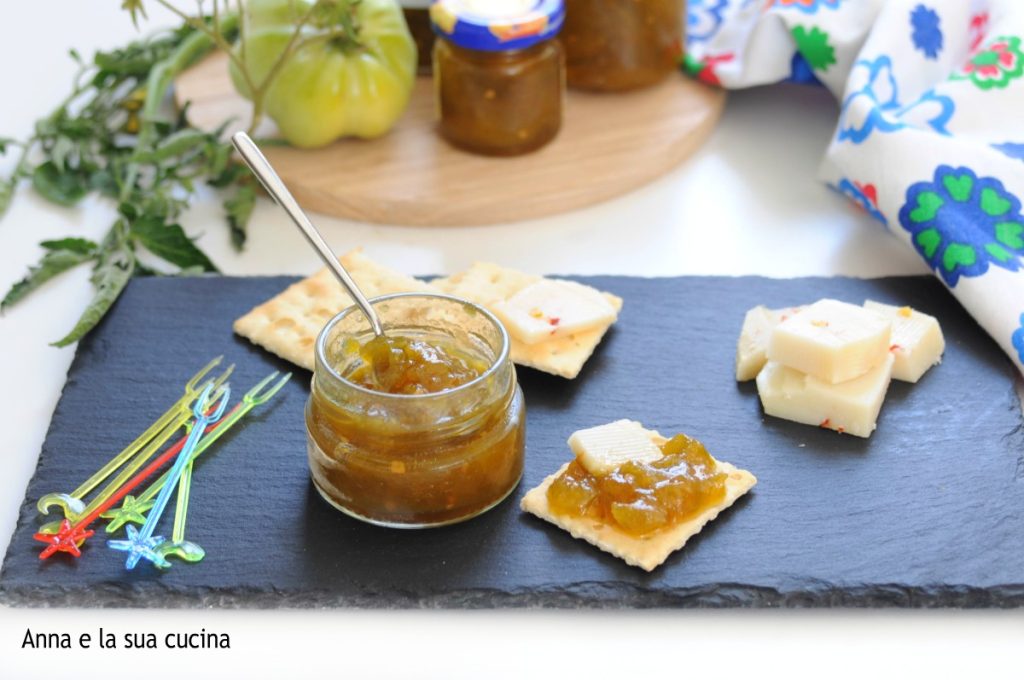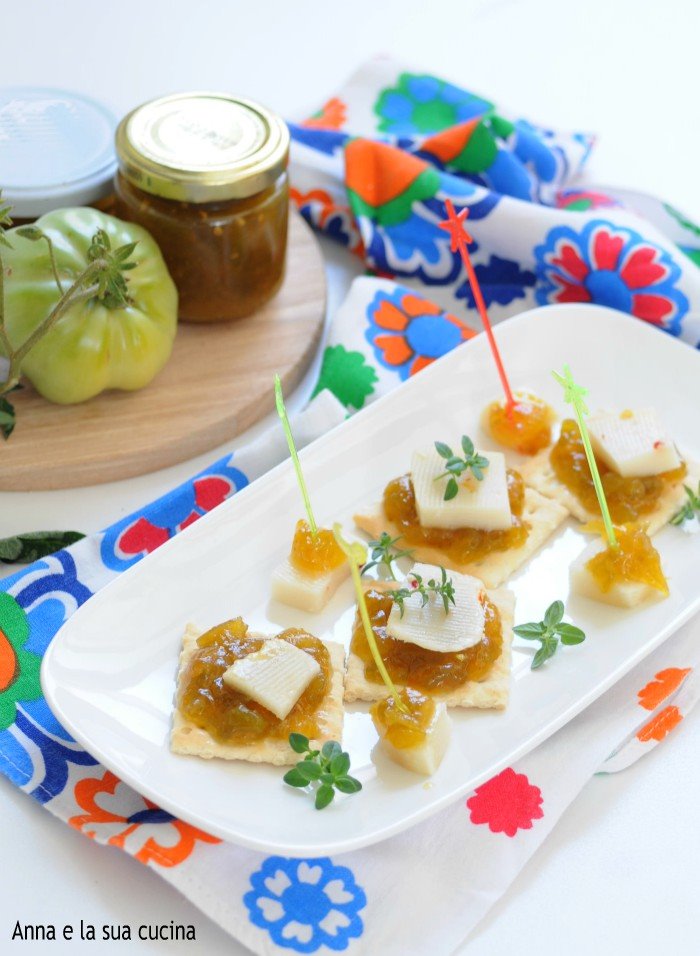The green tomato jam without pectin is a really delicious sweet preserve; its slight acidity makes it perfect to pair with both savory and sweet foods.
It is excellent to enjoy with aged and flavorful cheeses, with meat or fish, or simply for breakfast or a snack on a slice of bread or toast.
For those who love this kind of jam, you can always fill a simple tart or shortcrust cookies.
Green tomato preserve is a very simple recipe and it is prepared like a simple jam/preserve. The important thing is to choose unripe green tomatoes; you can pick them before they change color, or use those from the plant that did not ripen by the end of the season, staying between green and rosy.
Make a good stock for this winter; it’s also a great homemade Christmas gift!
YOU MIGHT ALSO BE INTERESTED IN THESE RECIPES

- Difficulty: Easy
- Cost: Economical
- Preparation time: 20 Hours
- Portions: 4 small jars
- Cooking methods: Slow cooking
- Cuisine: Italian
- Seasonality: Spring, Summer
Ingredients for green tomato jam without pectin
- 2 lbs lbs Green tomatoes
- 1 cup cup Sugar
- 1 Lemon zest (grated)
- 1 Lemon juice
Tools
- 1 Pot
- 1 Stove
- 4 Jars
Preparation for green tomato jam without pectin
For the preparation of this jam, get good organic green tomatoes.
I recommend starting the preparation the night before because they need to rest for many hours in the fridge.
For one kg of cleaned tomatoes, at least 300 gr. of sugar is needed.Wash the tomatoes well, dry them, and then divide them into 4 pieces, removing the stem, seeds, and any imperfections. Weigh the final product and then calculate the weight of the sugar.
Place the chopped tomatoes in a bowl, add the sugar, lemon zest for freshness, and juice for color brightness; otherwise, it oxidizes. Mix everything well, cover with plastic wrap, and let it rest in the fridge overnight.
The next morning, the sugar will be dissolved. Pour everything into a saucepan, place it over the heat, and cook, stirring occasionally until it thickens, which takes about an hour. Check well and remove the foam that forms on the surface.
In the meantime, sterilize the jars by boiling them with the lids in a pot covered with water for at least 20 minutes, remove them with tongs, and let them dry on a clean tea towel.Once the jam has reached the desired density, it’s quite coarse; blend it for a smoother and more homogeneous texture. The jam shouldn’t be too dry, as it will thicken with further boiling.
While still hot, pour it with a ladle into sterilized jars, close them tightly with new lids, and sterilize the closed jars covered with hot water by boiling for about 15/20 minutes for medium jars and 30 for larger ones.
You can also use a pressure cooker for sterilizing jars, using less water.
The final sterilization ensures greater product safety with longer preservation, compared to using the vacuum method with overturned jars while still hot.
Let the jars cool inside the pot; when they are cool, check the vacuum seal by pressing the center of the lid. If you don’t hear the classic ‘click-clack,’ the vacuum is achieved; otherwise, replace the lid and redo the sterilization or store in the fridge and consume within 2 days.
Dry, date, and store the product in a cool, dry place away from light and heat sources, for about 6 months. It is recommended to wait at least 2-3 weeks before consuming the jam/preserve.The difference between marmalade and jam depends on the type of fruit; marmalades are made with citrus fruits: oranges, mandarins, bergamot, cedars.
Jams, on the other hand, are made with all other types of fruit: peaches, apples, apricots, strawberries, etc.
Read here:
orange marmalade with Kenwood
Read here:
strawberry jam
cherry jam
apple and cinnamon jam
pear and chocolate jam
grape jam
fig jam
quince jam

Anna recommends…
Once opened, consume within 10 days maximum and store the product in the fridge. Therefore, it is advisable to use small jars to avoid prolonged opening.

